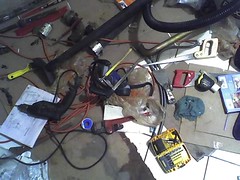
There's nothing like the right tool for the right job. I learned this quickly while installing an Ikea sink in the second-floor apartment. After we had our helper, Luis, put in a 12-inch tile floor, diagonally set, I took on the task of building and connecting the Värde sink and Värde cabinet.
First of all, my first mistake was using a non-variable speed drill made by Skil. When a screw became stuck, the drill nearly wrenched off my arm. Being too lazy to go and find my DeWalt drill, I made do for the duration of this job but was never comfortable. My suggestion: Avoid power tools by Skil. I've yet to go wrong with DeWalt purchases. (My latest purchase: A DeWalt D26441K Heavy-Duty 2.4 Amp Orbital 1/4 Sheet Sander with Cloth Dust Bag
The next piece of information I discovered about the house was that the supply and drain pipes ran sideways into the pantry instead of toward the back wall. Either it was due to a poorly done renovation, different building codes when the townhouse was built in 1901 or some combination of the two. Not having the wherewithal to reroute water lines at that moment, I drilled holes into the side of the cabinet. (Besides, I had already paid a plumber to vent the pipes pointed out in my pre-purchase building inspection.) Not an ideal solution, I admit, but it would allow the job to get done.
More than a year after having installed the sink, I'd have to say it has held up relatively well in the rental unit, which has been inhabited by at least three tenants most of that time. There are scratches across the stainless steel sink surface, but that's to be expected. But surprisingly, the doors and hinges still work flawlessly, a testament to some fine Swedish design and engineering. I selected the single-lever Bågvik faucet for its looks and its convenience — although the sink required drilling in order to mount it — yet it has proved to be durable, as well. Go figure!


